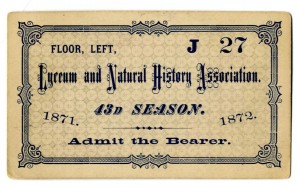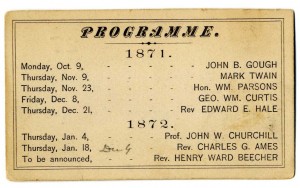On September 23-24, 2011, the American Antiquarian Society will host a symposium titled “The Cosmopolitan Lyceum: Globalism & Lecture  Culture in Nineteenth-Century America.” This conference was organized by Dr. Tom Wright, of the University of Oxford.
Culture in Nineteenth-Century America.” This conference was organized by Dr. Tom Wright, of the University of Oxford.
So what’s a lyceum, anyway? Throughout the nineteenth century, the lyceum—a scheduled public lecture that was intended to be both educational and entertaining—was one of the dominant modes that Americans in cities large and small learned about the larger world and spent their evenings. These lectures were delivered in learned societies (like AAS), academies, mechanics’ institutes (like Worcester’s own Mechanics’ Hall), or on commercial tours, and they provided writers like Ralph Waldo Emerson and Mark Twain with a way to make a reliable living. As such, these lectures occupied a middle ground between the printed world of books and the purely performative world of the theater. They also helped spread both scientific knowledge and social reform, as topics ranged from geology and medicine to temperance and women’s suffrage.


The lyceum was also “cosmopolitan,” in that it provided a venue for well-known foreigners to speak, and it familiarized American audiences with parts of the world they would never see. This conference will be similarly cosmopolitan, as it features speakers from the U.S. and Europe, as it explores the ways in which lecturing engaged with and made use of global knowledge, realities, and experience.
The Cosmopolitan Lyceum symposium is open to the public. Further information, a conference program, and registration details can be found on the AAS website at www.americanantiquarian.org.

One thought on “The Cosmopolitan Lyceum”